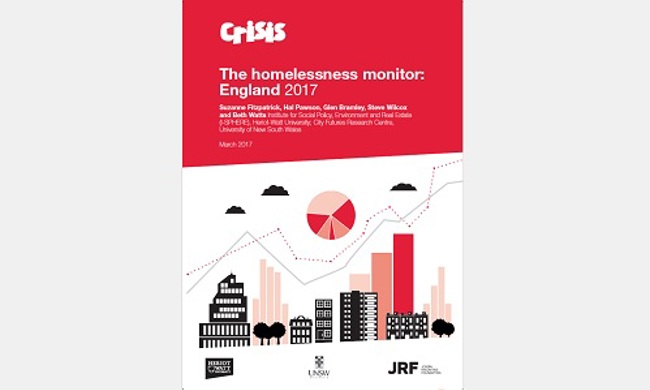Homelessness Monitor: England 2017
06.04.2017
The Homelessness Monitor: England 2017 is the sixth annual report of an independent study, funded by Crisis and the Joseph Rowntree Foundation, of the homelessness impacts of recent economic and policy developments in England.
Key findings
- In 2016 rough sleeping has risen by 132% since 2010 according to official estimates. Statistics routinely collected by the ‘CHAIN’ system similarly show London rough sleeping having more than doubled since 2010. A recent reduction in Central and Eastern European nationals rough sleeping has masked the ongoing increase in the number of UK nationals sleeping rough.
- There were 58,000 ‘homelessness acceptances’ by local authorities in England in 2014/15. This is 18,000 higher than in 2009/10. Administrative changes mean that these official statistics understate the increase in ‘homelessness expressed demand’ over recent years. There were some 271,000 ‘local authority homelessness case actions’ in 2015/16, a rise of 32% since 2009/10.
- Regional trends in homelessness have remained highly contrasting, with acceptances in the North of England in 2015/16 some 6% lower than in 2009/10 (the national low point), while in London the latest figure was more than double (103% higher than) that at this previous low point. There is evidence to suggest that some of the extreme pressure that has accumulated in London over recent years has begun to be seen nationwide.
- The increase in statutory homelessness is partly attributed to the sharply rising numbers made homeless from the private rented sector, with relevant cases having almost quadrupled over the period – from less than 5,000 to almost 18,000. As a proportion of all statutory homelessness acceptances, such cases had consequentially risen from 11% to 31 per cent since 2009/10.
- Since bottoming out in 2010/11, homeless placements in temporary accommodation have risen sharply, with the overall national total rising by 9% in the year to 30 June 2016; up by 52% since its low point five years earlier. B&B placements have been rising even faster, and now stand almost 250 per cent higher than in 2009.
- The welfare cuts introduced in this decade, and those planned for introduction in the coming years, will cumulatively reduce the incomes of poor households in and out of work by some £25 billion a year by 2020/21. This is in a context where existing welfare cuts, economic trends, and higher housing costs associated with the growth of private renting have already increased poverty amongst members of working families to record levels.
Research
Fitzpatrick, S., Pawson, H., Bramley, G., Wilcox, S. & Watts, B. (2017) The Homelessness Monitor: England 2017, London: Crisis.

